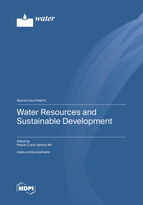Water Resources and Sustainable Development
A special issue of Water (ISSN 2073-4441). This special issue belongs to the section "Water Resources Management, Policy and Governance".
Deadline for manuscript submissions: closed (30 September 2023) | Viewed by 28914
Special Issue Editors
Interests: water resources; hydrogeology; groundwater quality; groundwater pollution; groundwater modeling; health risk assessment; geochemical modeling; hyrogeochemistry
Special Issues, Collections and Topics in MDPI journals
Interests: groundwater quality; aquifer permeability; groundwater modeling; hyrogeochemistry; hydrogeology
Special Issues, Collections and Topics in MDPI journals
Special Issue Information
Dear Colleagues,
Water resources are indispensable for human survival, social development and economic growth. However, climatic changes, population growth and excessive economic development will lead to a number of water-related problems in the long-term, affecting the sustainable development of society and economy. Water pollution, water scarcity and many other water-related problems have emerged in nearly every corner of the world, which has attracted considerable attention from the public and professionals. Facing these problems, many nations and researchers have already taken action to protect water quality and quantity and mitigate the water crisis caused by climate change and human activities. This Special Issue “Water Resources and Sustainable Development” will provide a platform for researchers and policy makers to share their latest thoughts and new findings on this topic, as well as new methods to deal with water-resource problems. This will be a multidisciplinary Special Issue focusing on the intercorrelation of natural sciences and social sciences. The topics covered by this special issue include but are not limited to:
- Identification of water-recharge resources;
- Assessment of water quality;
- Integrated water management;
- Water-pollution control;
- Management of groundwater depletion;
- Impacts of mining activities on water resources;
- Health-risk assessment;
- Water-resources modeling;
- Groundwater–surface water interaction;
- Water footprint;
- Flood-water management;
- Aquifer characterization;
- Soil-water research.
Prof. Dr. Peiyue Li
Dr. Jianhua Wu
Guest Editors
Manuscript Submission Information
Manuscripts should be submitted online at www.mdpi.com by registering and logging in to this website. Once you are registered, click here to go to the submission form. Manuscripts can be submitted until the deadline. All submissions that pass pre-check are peer-reviewed. Accepted papers will be published continuously in the journal (as soon as accepted) and will be listed together on the special issue website. Research articles, review articles as well as short communications are invited. For planned papers, a title and short abstract (about 100 words) can be sent to the Editorial Office for announcement on this website.
Submitted manuscripts should not have been published previously, nor be under consideration for publication elsewhere (except conference proceedings papers). All manuscripts are thoroughly refereed through a single-blind peer-review process. A guide for authors and other relevant information for submission of manuscripts is available on the Instructions for Authors page. Water is an international peer-reviewed open access semimonthly journal published by MDPI.
Please visit the Instructions for Authors page before submitting a manuscript. The Article Processing Charge (APC) for publication in this open access journal is 2600 CHF (Swiss Francs). Submitted papers should be well formatted and use good English. Authors may use MDPI's English editing service prior to publication or during author revisions.
Keywords
- water resources
- water quality
- water management
- water pollution
- water depletion
- water-resources development
- water-resources protection
- health-risk assessment
- water-resources modeling







